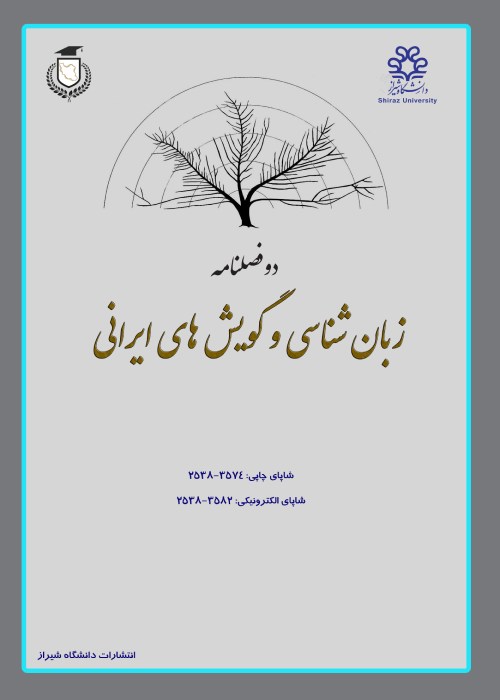A Typological Approach to Possessive Construction in Sorkhi Dialect
Possession is a relatively abstract concept that is a bit difficult to define it explicitly. But the speakers of any language can have an understanding of the mentioned concept based on their linguistic background. To express the concept of possession in languages, the presence and participation of possessor and possessee are required. Between these two, there is an asymmetric relationship of belonging; in a way that the property belongs to the owner, but there is no opposite of this relationship (Stassen, 2009: 11).This research examines the possessive construction in Sorkhi dialect based on the typological approach of Croft (2003). Sorkhi dialect is one of the five common dialects in the Koohmare Sorkhi region of Shiraz city in Fars province. Koohmare Sorkhi is one of the oldest residential regions of Fars province. In terms of country divisions, this region is a part of Shiraz city. Sorkhi dialect is one of the southwestern dialects of Iran, and its speakers live in villages such as Bagdane, Romqan, Shurab and Siakh. The structure of the research is a way that the second part of the paper examines the background of studies conducted in possessive construction. In the third part, it examines the different methods of showing possessive construction, how the relationship between the possessor and the possessee, and the distinction between inalienable and inalienable possession from the typological point of view. In the fourth part, the possessive construction in Sorkhi dialect is introduced, and in the final part, the results of the research are presented.
This research is a field survey which is done through using some questionnaires and speaking to Sorkhi speakers. About 500 sentences were gathered and then analyzed using the typological approach of Croft (2003). Since there has been no research on the possessive construction in Sorkhi dialect, the studies conducted on this construction in the Persian language will be discussed. As Sharifi (2009) writes, not much research has been done on possessive construction in Persian grammar and most of the linguistics have included this construction under the name of genetive construction. As an example, we can mention writers such as: Nadimi (1975), Jafari (1983), Vahidian and Omrani (2011).
The strategy of making possessive in this dialect is to use linkers. The linker of this dialect - which is the genitive sign - is derived from the relative pronoun (which itself is an indexical morpheme) and turned into a linker during the process of grammaticalization. Croft (2003: 32-45) considers the linker as a morpheme that appears between a noun and a possessive pronoun, and thus it is dependent on both constructions, and according to this point of view, the possessive construction in Sorkhi dialect should be considered as consisting of three morphemes. In the possessive construction of this dialect, regardless of the type of possessor and possessee, first the possessee and then the possessor is placed together and the connection between them is established by using the linker.Another strategy of possessive construction in this dialect is the use of the juxtaposition strategy without the involvement of any additional morphemes. The study of the data showed that this dialect uses the juxtaposition strategy for possessive construction in the following two cases.The third strategy of possessive construction in the Sorkhi dialect is the affixation strategy and it is mostly used when the possessor is a pronoun. Mahoutian (2011: 149) believes that in this method, the clitic is used. In this strategy, the possessor is connected to the possessee by a clitic and both structures appear as a single word.In the Sorkhi dialect, the verb root /hen/ is used in the construction of "to have", and the construction of "belonging" is shown with the help of the word "māle". Both constructions of "having" and "belonging" are used to express alienable possessive. Theconstruction of "belonging" cannot be used to express inalienable possession. On the other hand, the statement of inalienable possession can be made with the help of "having". The second difference between the constructions of "having" and "belonging" is in the arrangement of their constituents. In the construction of "having" it is possessor-possessee, and in the construction of belonging it is possessee-possessor. Another issue is the investigation of whether the possessor and possessee are known or unknown. In the Sorkhi dialect, in the four cases of known possessor and possessee, known possessor and unknown possessee, unknown possessor and known possessee, unknown possessor unknown and unknown possessee, both the construction of "having" and the construction of "belonging" can be used. The following examples show this fact. But another issue is the investigation of whether the possessor and possessee are known or unknown. In the Sorkhi dialect, in the four cases of known possessor and possessee, known possessor and unknown possessee, unknown possessor and known possessee, unknown possessor unknown and unknown possessee, both the construction of "having" and the construction of "belonging" can be used.
According to what has been said, it can be concluded that Sorkhi dialect uses three strategies of concatenation, juxtaposition, and affixation to build possession. One of these strategies is the one in which there is an increase in morphemes, and the other is among the simple strategies that do not add any morpheme to possessor and possessee. The first strategy is to use the linker, the second is to use juxtaposition, and the third strategy is to use affixation without the involvement of any additional morphemes. which is one of the linking strategies. These three strategies are analyzed in the following table according to the three characteristics mentioned in the classification of Croft (2003).
- حق عضویت دریافتی صرف حمایت از نشریات عضو و نگهداری، تکمیل و توسعه مگیران میشود.
- پرداخت حق اشتراک و دانلود مقالات اجازه بازنشر آن در سایر رسانههای چاپی و دیجیتال را به کاربر نمیدهد.



